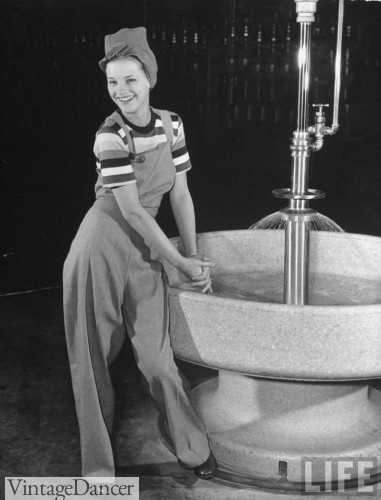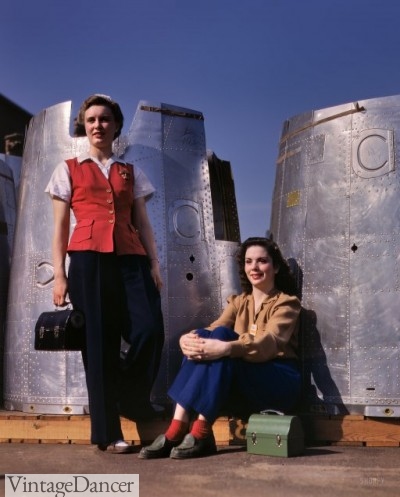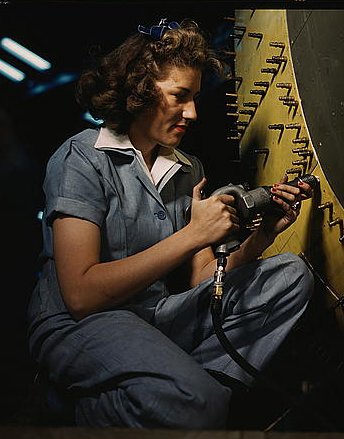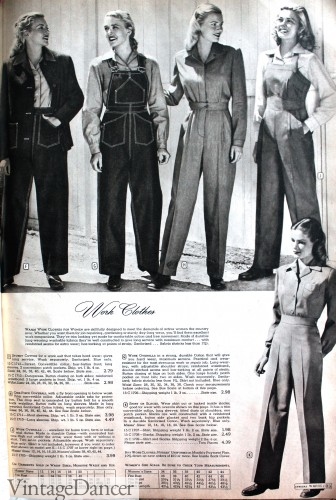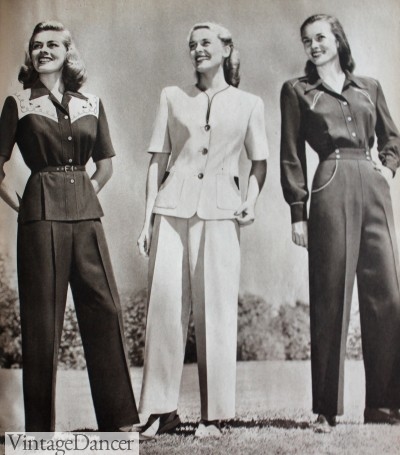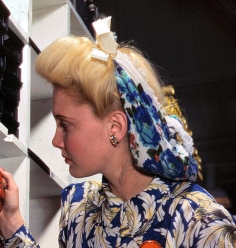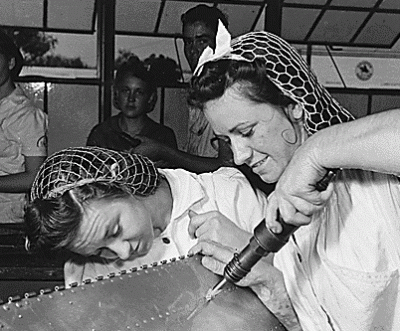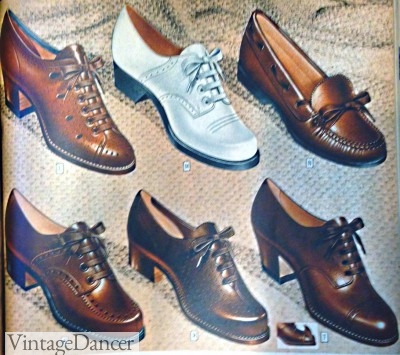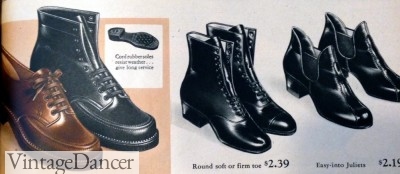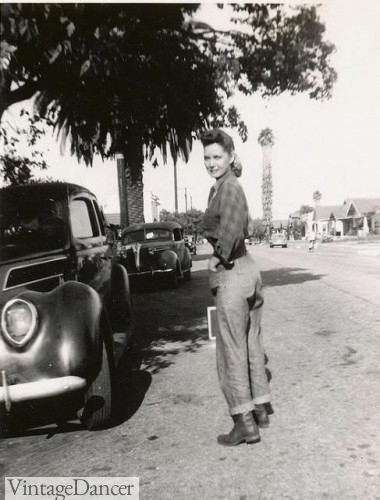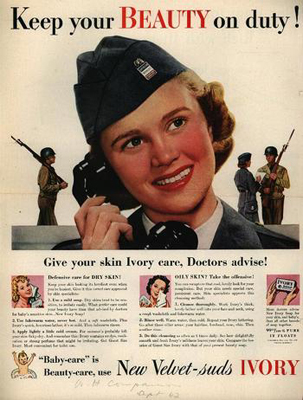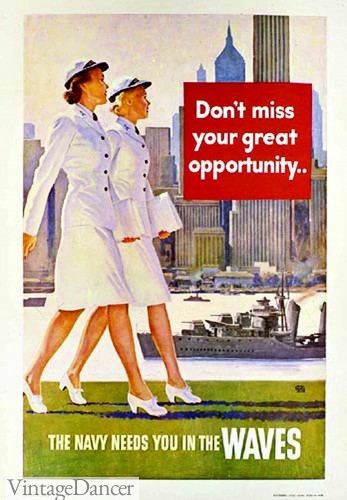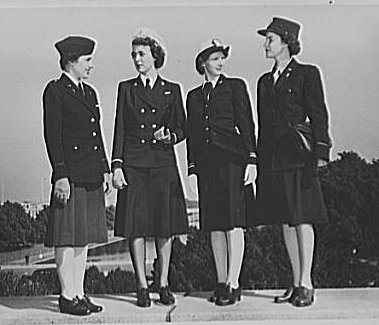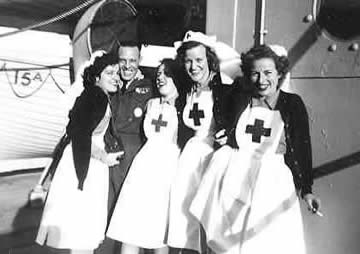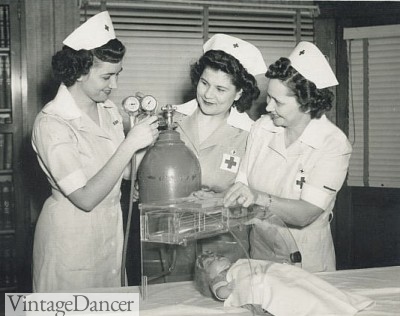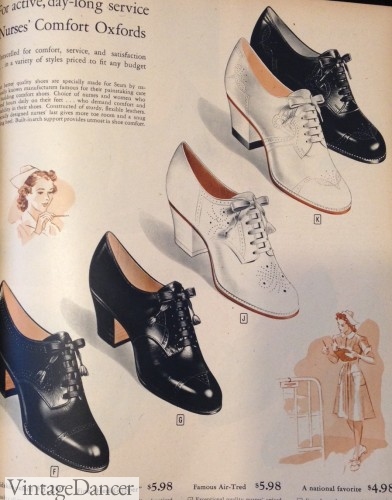The 1940s weren’t all play. A lot of the men in the U.S. were drafted for the war. While they were off at training and fighting overseas, women were encouraged to leave their homes and work in all sorts of jobs – from office work to factories, most notably in ammunition factories contributing to the war effort. Women were also recruited for direct service in the war, in non-combat positions, and as nurses. These new positions required new ladies’ workwear clothing designed for women’s bodies. Factory workers made use of overalls and sturdy separates, nurses made uniforms to spec, and office workers dressed in Victory suits. 1940s women’s workwear became part of a her wartime wardrobe, but she also adopted it into her everyday life after the war too. Clothing would be radically different today if it were not for women at work in the 1940s.
1940s Working Women- Who were they?
Between 1940 and 1945, American women in labor increased by 50 percent. Women with existing jobs were able to move into higher positions previously given only to men. At first, jobs were in sewing or line assembly, but eventually women were trained and moved into a job suitable for Rosie the Riveter. Women in manufacturing doubled, in defense plants leapt by 400%, and in the aircraft industry by 39%. Despite doing equal work as men, women never received equal pay. African American women also had more job options, although they were still very low paying ones such as housework for white women who now worked away from home, and low level factory cleaning jobs.
Lack of affordable childcare made it impossible for many married mothers to work and raise a family. Ironically, the fictional Rosie the Riveter was 35 and married – a rare employee during the war years. In Britain the “call-up” in 1942 was for single women and widows aged twenty to thirty. In Germany and Japan, women were NOT encouraged to work until the very end when defeat was within sight. Only about 25% of women kept on working after the war – many quit to return to domestic duties, while others were fired and replaced by returning men. Many working women resumed traditionally feminine jobs in healthcare, clerical, teaching, or production line operatives.
Ladies’ Workwear in Factories
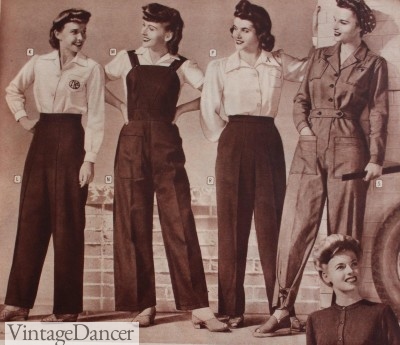
R to L- 1943 wide leg pants and blouse, overalls with blouse, tapered pants and blouse, and coveralls with optioned tapered leg cuff.
In an office setting, women would wear their normal clothes – primarily suits and rayon dresses. However, skirts were not practical for the factory work that women began to do, and they had to dress differently. At first they wore men’s work clothing which was then modified somewhat to fit women’s bodies better. They would wear either denim or cotton twill pants with a tucked in, short-sleeved button down blouse.
Often, and especially for munitions work, they would wear the now-famous ‘Rosie the Riveter’ coveralls. These were usually made of blue denim or heavyweight cotton canvas in brown, tan or blue. The coveralls buttoned down the front middle to get in and out, and were loose-fitting throughout, although they were sometimes fitted in the waist. They were often long-sleeved to offer protection, although some had short shirt-sleeves, and were fit tightly around the wrists and ankles to avoid loose ends getting caught in machines. They often had breast pockets to keep pens and small tools in. Coveralls were often worn with a cotton blouse underneath that was not visible, but certainly softer than stiff twill.
Factory workers also had to tie up their hair so that it wouldn’t get caught in machinery. They used either a turban or tied their hair back with a scarf. The scarf turban became an icon for industrial workers around the globe. Women in less dangerous positions would keep their hair shorter for easier maintenance or wear a knit snood to hold back longer hair. With soap being rationed, women had a harder time keeping hair clean. Favoring scarfs and snoods or wearing hair pinned up hid unsightly oil and dirt.
Proper shoes for industrial and factory work were very important both in terms of comfort (standing all day) but for safety, too. The slip on loafer with soft sole was the best choice for working around aircraft. The soft soles would not dent the airplane and a lack of straps or ties meant they could not get caught in machinery. Leather lasted the longest but was expensive, so sturdy woven fabrics were often used instead. For heavy duty “dirty” jobs women wore boots, usually men’s boots because so few options were made for women.
For light duty work, women could wear low heeled lace up Oxfords or wedge shoes. Peep toe heels and strappy sandals were not acceptable. Shoes were very plain and boring but also comfortable. Women adopted “comfort” shoes for wearing at home too, at least while their husbands were away. The moccasin loafer was extremely popular in the 1940s as a comfort and work shoe. Read more about 1940s women’s shoe styles.

My Rosie Look – Get a similar costume here.
Beauty in the Work Force
What workwear lacked in feminine clothing lines, it made up for in cosmetics. Face creams were often given to women to protect their skin from chemicals. War time propaganda encouraged women to wear makeup and stay beautiful – to give something for the men to look forward to seeing when they come home. Women frequently had to miss work due to beauty parlor appointments, so many larger companies installed parlors on company grounds. Many uniformed jobs had a model of beauty each women had to maintain. This often encouraged a specific hairstyle, shade of lipstick, and eye and blush colors that complimented the uniform colors. Looking well was almost as important as doing the job well.
Learn all about 1940s makeup and how to create the natural 40s look ideal for working women.
Ladies’ Workwear Uniforms
Women didn’t fight in the war, but they did join the Army and Navy as clerical workers. Uniforms were made stylish so as to attract women to service, and they looked somewhat similar to the suits that women were already wearing. The WAVES, Women Accepted for Voluntary Emergency Service, were part of the US Navy and were considered the most fashionable of all working ladies. Their uniform was designed by Mainbocher, an American born French designer. The uniform consisted of a white blouse with a small navy scarf underneath a navy jacket. The jacket was shaped similarly to a suit jacket of the time, but slightly looser-fitting and with more severe shoulder pads. It had gold buttons down the front with two breast pockets with gold buttons. The jacket sometimes had two gold, silver or bronze embroidered stripes and a star at the wrists, depending on the rank of the woman wearing it. This topped off an A-line navy skirt that came to the knee. A navy cap with a small brim, sometimes white with navy brim, was also worn. The Women’s Reserve of the Coast Guard (SPARS) also wore the same uniform. An all white version (pictured above) was the formal uniform of the WAVES.
The WAC, Women’s Army Corps, wore a very similar uniform. Instead of white and navy, the WAC uniform was all tan-colored, including the blouse. A tan tie went with the shirt, and a tan cap with a small brim was worn. The jacket had gold buttons as well.
Women also volunteered as nurses with the Red Cross during the war, many of them serving overseas. The uniform for nurses was a standard shape, but came in several colors depending on the duties the nurse performed. It was a basic shirtwaist dress with a pointed collar and buttons all the way down the front. The skirt was A-line. Nurses’ dresses were a little bit longer than a regular skirt, reaching a couple of inches below the knee. They came in both short-sleeves and long, with the long sleeves coming to a cuff at the wrist. They had a self-fabric belt worn at the waist and were made of cotton. They were either grey, medium to light blue, or white with white buttons. The grey and blue dresses had a white collar and cuffs. The dresses had an embroidered Red Cross symbol on the left side of the chest. The dresses were worn with a small, round white cap with a red cross symbol on the front. A white cotton apron was worn over the dress when working. It tied at the waist and was slightly shorter than the dress. The front was square at the neckline and it had a large red cross symbol in the center.
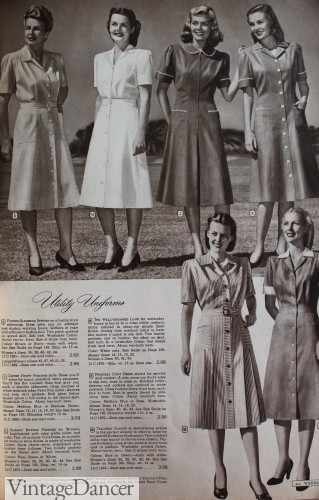
1947- Generic nurses uniforms and Utility (work) dresses including the Kitty Foyle Dress (Right most dress)
There are different uniforms for the the different countries participating in the war. They all had similarities to each other, as most fashion of a decade does. There are a handful of good websites providing history and repro uniforms. Start with http://www.paddelaters.com/wwII-wwii-womens-uniforms-accessories.php to see some ready made uniforms.
Learn more 1940s fashion history here.
Debbie Sessions has been teaching fashion history and helping people dress for vintage themed events since 2009. She has turned a hobby into VintageDancer.com with hundreds of well researched articles and hand picked links to vintage inspired clothing online. She aims to make dressing accurately (or not) an affordable option for all. Oh, and she dances too.
